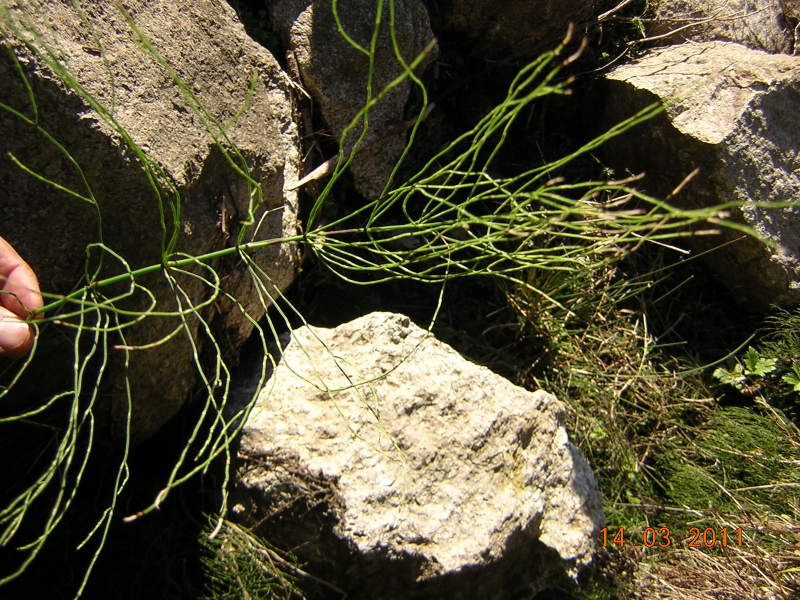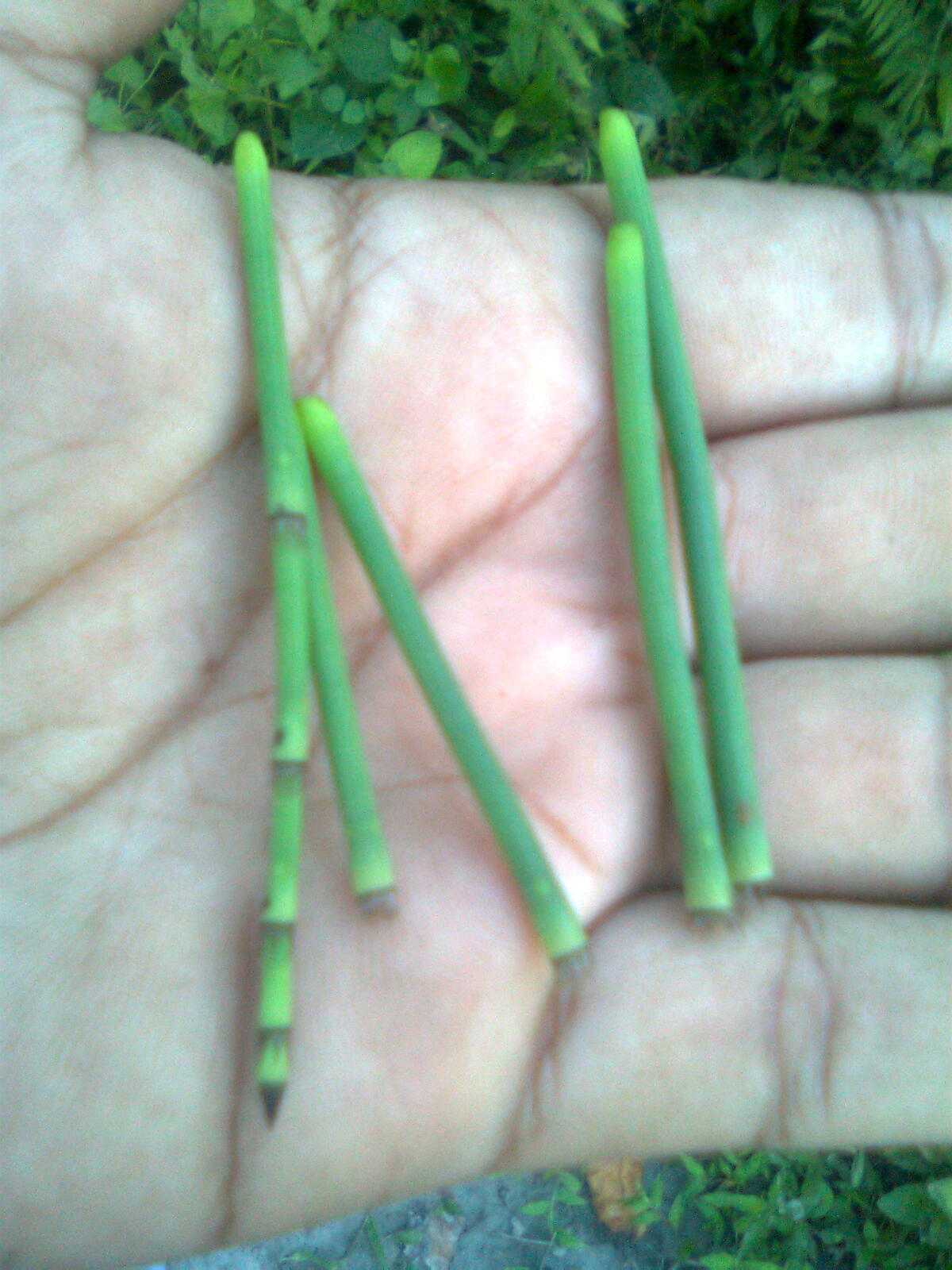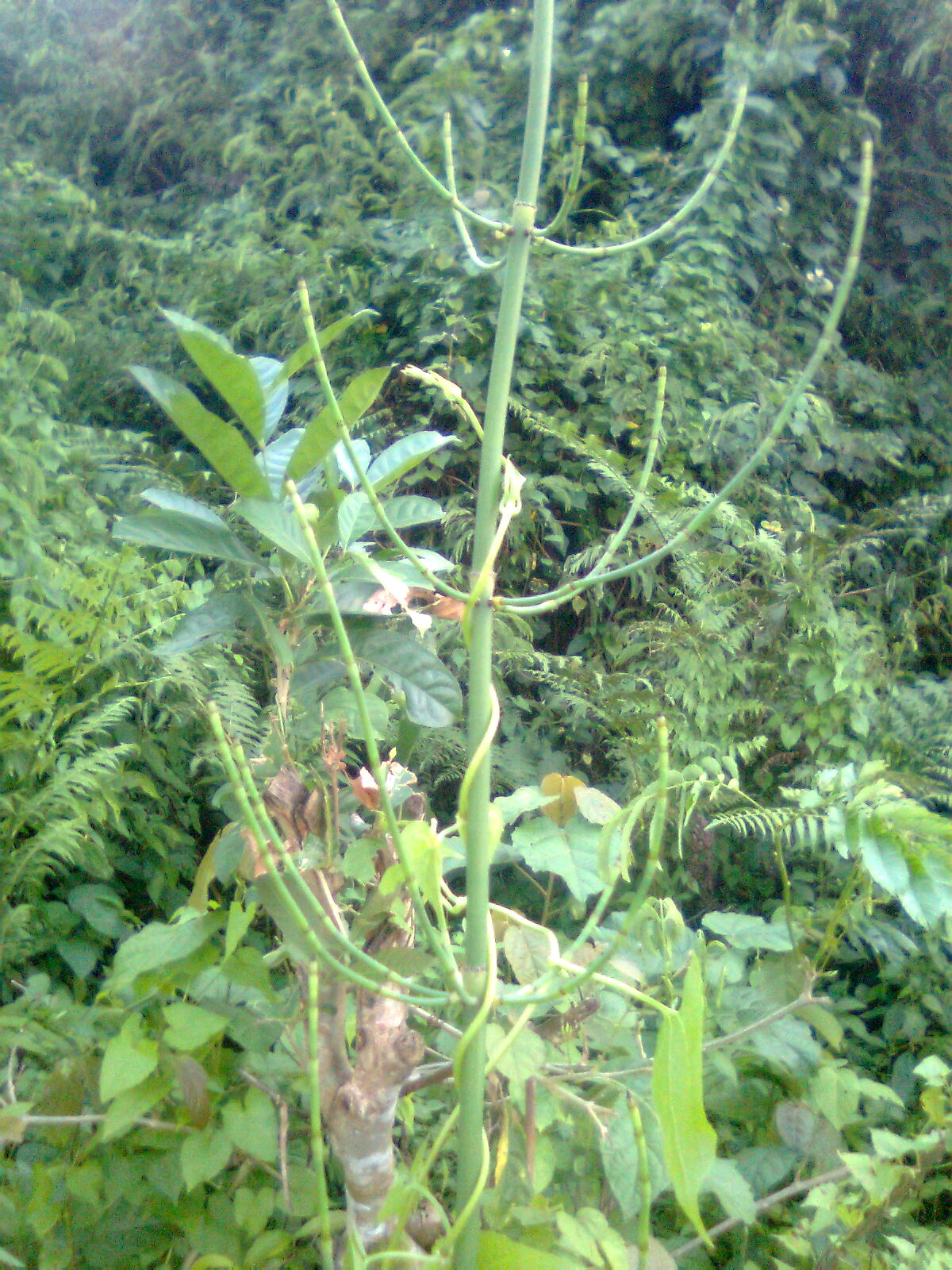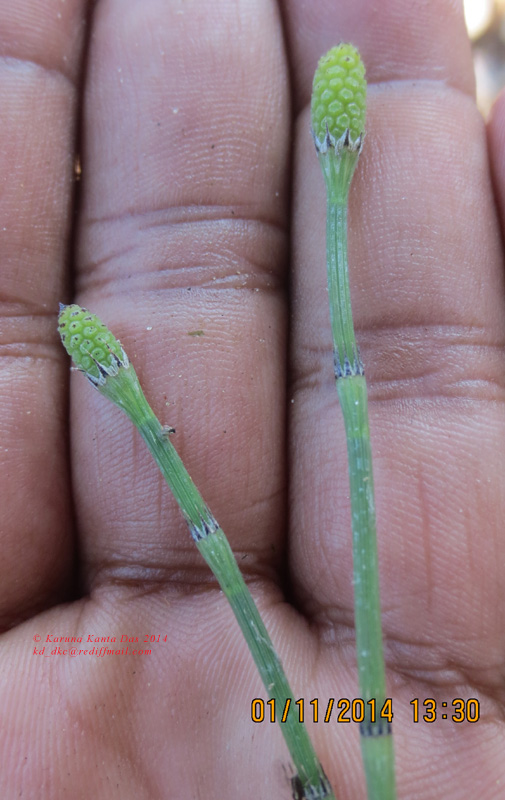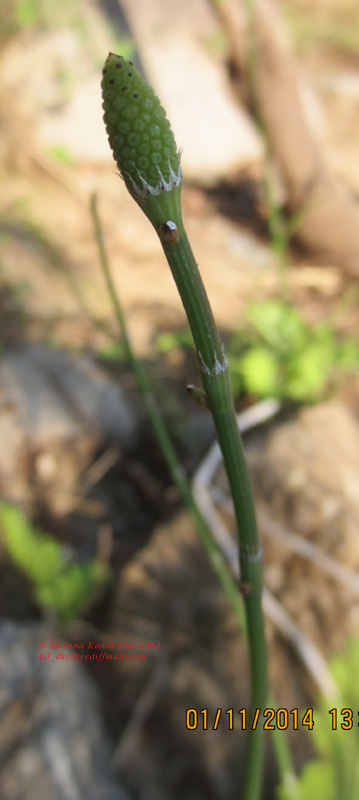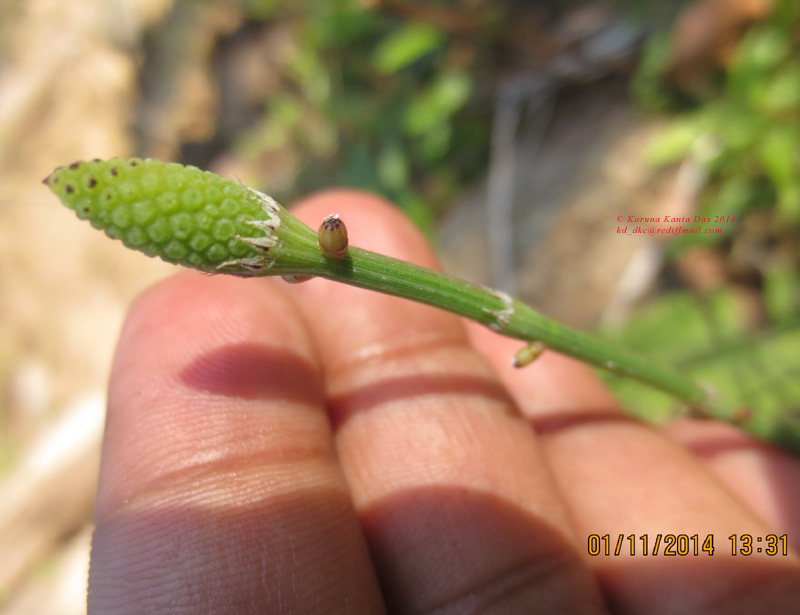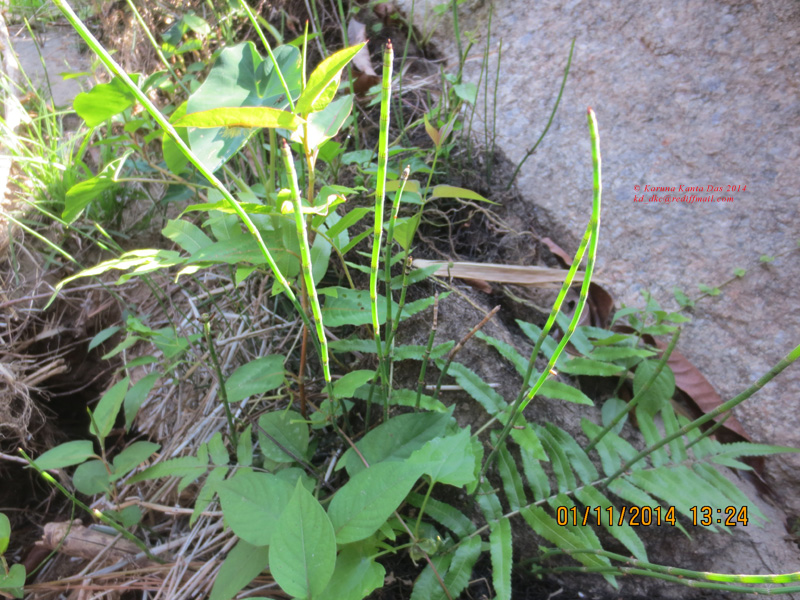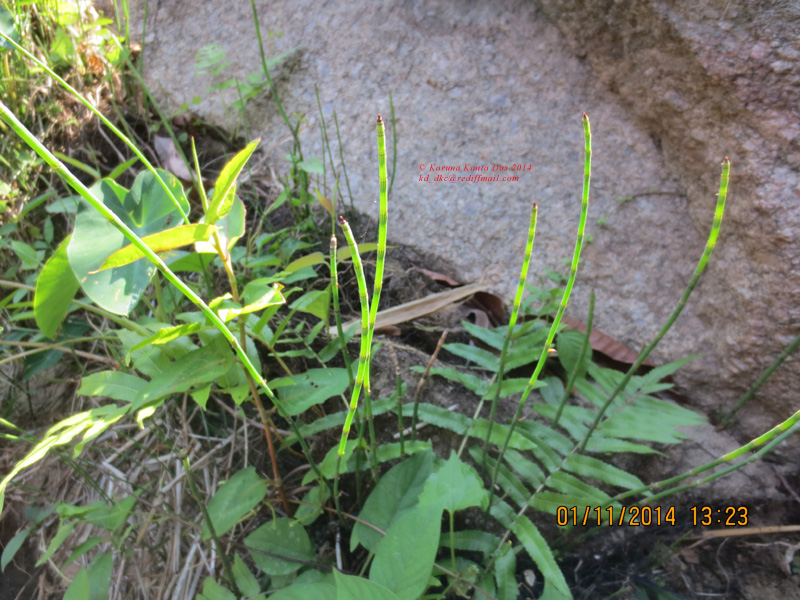|
Equisetum ramosissimum var. huegelii (Milde ) Christenh. & Husby, Bot. J. Linn. Soc. 189: 343 (2019) (syn: Equisetum aquaticum Noronha ; Equisetum debile Roxb. ex Vaucher ; Equisetum debile var. caespitosum Milde; Equisetum debile var. divaricatum Milde ; Equisetum debile var. gracile Milde ; Equisetum debile var. laevissimum Milde ; Equisetum debile var. majus (Milde ) Milde ; Equisetum debile var. minus (Milde ) Milde ; Equisetum debile var. pashan Mahab. ; Equisetum debile var. polystachyum Milde ; Equisetum elongatum var. malabaricum Milde ; Equisetum huegelii Milde ; Equisetum huegelii var. majus Milde ; Equisetum huegelii var. minus Milde ; Equisetum laxum Blume ; Equisetum ramosissimum var. altissimum (A.Braun) Bir ; Equisetum ramosissimum f. debile (Roxb. ex Vaucher) Fraser-Jenk. ; Equisetum ramosissimum subsp. debile (Roxb. ex Vaucher) Hauke ; Equisetum ramosissimum var. malabaricum (Milde ) Milde ; Equisetum timorianum Vaucher ; Equisetum virgatum Blume ; Hippochaete debilis (Roxb. ex Vaucher) Holub ; Hippochaete ramosissima subsp. debilis (Roxb. ex Vaucher) Á.Löve & D.Löve );
. Tropical & Subtropical Asia to SW. Pacific: Assam, Bangladesh, Borneo, Cambodia, China North-Central, China South-Central, China Southeast, Fiji, Hainan, India, Jawa, Laos, Lesser Sunda Is., Malaya, Maluku, Myanmar, Nepal, New Caledonia, New Guinea, Philippines, Solomon Is., Sri Lanka, Sulawesi, Sumatera, Taiwan, Thailand, Tibet, Vanuatu, Vietnam as per POWO; .
Location Kalatope chamba dist – This plant is rough to touch and was used in older times to clean utensils (like we use scotch bright now) and hence named as scouring rush also.
A few species for you to help me id.
1. Image0200 & 0201 was shot in Sadiya, Assam. I don’t know what its called exactly but I call it Indian Lego Plant. As in case of lego they can be attached and detached to create beautiful structures, the stems of this plant can also be detached and reattached.
………………………….
Image0200 & 0201 Equisetum diffusum (Pteridophyte) First two are Equisetum debile Roxb. ex Vaucher Mém. Soc. Phys. Genève 1: 387. 1822 (Pteridophyte: Equisetaceae) also called horsetail fern. Equisetum sp. from Meghalaya KD 11 Nov : 4 posts by 2 authors. Attachments (6)
Attached images are Equisetum sp. Please ID the plant
Date :01.11.2014
Location: North Garo Hills, Meghalaya
Family : Equisetaceae
Genus & species :Equisetum sp.
Habitat: Grows wild near the stream on sandy soil
Habit : Herb Equisetum ramosissimum– observe the pointed cone-apex. I can’t say if it is forma ramosissimum or forma debile without seeing it in front of me, but debile is commoner there – and those two forms are not so important it seems. SK700 05 AUG-2017:ID : 3 posts by 2 authors. Attachments (9)
Location: Godawari, Nepal
Altitude:5000 ft.
Date: 22 June 2017 Equisetum sp ?? Yes, of course. E. ramosissimum (most is the forms debile, ehich is hardly worth recognising taxonomically). Do feel free to contact Dhan Raj Kandel, Dept. of Plant Resources, Godavary, for both identification and access to literature. GBIF I am following POWO in this case. See this Equisetum species in a cultivated garden in Thane in December 2016. Papyrus leaves can also be seen in the background.
Requested to please provide ID, if possible from this limited set of pics.
It rather depends how tall it is – would I be right in thinking it’s a really tall, if not enormous plant, 10 to 15 ft high or more? If so then it would be the exotic S. American E. robustum, which is occasionally grown in Botanic Gardens.
But if not very big, there is the common E. ramosissimum from throughout India (with rather insignificant forms ramosissimum and debile) – both these species are in the section Hippochaete with hard stems and pointed tops to the “cones”.
But I don’t think E. ramosissimum normally has so much nice coloration on the sheathes, so probably, if it’s big enough. it should be E. robustum. If I remember rightly it was also grown in the fern-house at the National Botanical Research Institute gardens in Lucknow. Thanks … .
Equisetum arvense L. SN June 10 : 1 post by 1 author. Attachments (3).
Equisetum arvense L, wild horsetail,
Pteridophyte from Coonor, Nilgiri, Tamilnadu at an altitude of 1500m, I think it will be Equisetum ramosissimum as per details in Flora of Peninsular India. I think Equisetum arvense is not reported from the area (Subarctic & Temp. Northern Hemisphere as per POWO)
. References:
POWO |
Disclaimer
1. For any mistake in identification or for becoming efloraofindia e-group member (for contributing towards building of efloraofindia or otherwise), pl. mail to indiantreepix@googlegroups.com or itpmods@googlegroups.com
2. For better viewing of species’ pages, colour scheme & formatting is being followed as: Description of the species, Details of other flora species on the same page, Uses/ harms, Distribution, Abundance/ Location/ Flowering time & date, Habit & habitat, Etymology & pronunciation, Other interesting information, stories etc., Others, Botanical names, Common names, Main point of discussion below, Discussion about Botanical names.
Navigation
- Award for eFloraofIndia
- Colour scheme & formatting
- Copyrights, Permissions, Citations
- eFloraofIndia appreciated
- Names of Plants in India site
- Flowersofindia site
- Posting Guidelines
- For members’ information
- Logo, Tagline, Acronym
- Volunteers required
- ‘Pitamah’ of eFloraofIndia
- ‘अजेय’ ‘Ajey’ of eFloraofIndia
- ‘Saarthi’ ‘सारथि’ of eFloraofIndia
- ‘Jewel’ of eFloraofIndia
- ‘Grassman’ of eFloraofIndia

